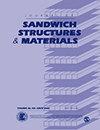Bending response and failure characteristics of nomex honeycomb sandwich with continuous composite facesheet encasement
IF 2.8
3区 材料科学
Q1 ENGINEERING, MECHANICAL
引用次数: 0
Abstract
In conventional sandwich construction, the core component is typically made of Nomex honeycomb and sandwiched between two facesheets, a lower and an upper facesheet. To enhance the load-bearing capacity of this Nomex honeycomb core sandwich (NHCS) construction, we propose a NHCS construction that is continuously encased by a composite fabric facesheet on all four sides. We experimentally and numerically examine the bending response of this encased NHCS construction through a three-point bending test. We consider and discuss the effect of the orientation of the honeycomb core component and the formation of the facesheet separately to reveal the mechanism by which the composite facesheet encasing enhances the construction. Our results demonstrate that composite facesheet encasing significantly improves the bending response of the NHCS construction, with a much greater advantage than the increase in mass compared to conventional sandwich construction. The superiority of the encased composite facesheet is significantly influenced by the orientation of the honeycomb cell and the direction of the fiber ply-stacked laminate facesheet. In addition, we compare the bending response of the encased honeycomb sandwich construction with that of competing sandwiches and show that the proposed sandwich with a continuously encased composite facesheet has a superior lightweight advantage.nomex连续复合面壳蜂窝夹层弯曲响应及破坏特性
在传统的夹层结构中,核心组件通常由Nomex蜂窝制成,夹在两个面板之间,一个下面板和一个上面板。为了提高Nomex蜂窝芯夹层(NHCS)结构的承载能力,我们提出了一种NHCS结构,该结构的四面连续包裹着复合织物面板。我们通过三点弯曲试验实验和数值研究了这种封闭NHCS结构的弯曲响应。我们分别考虑和讨论了蜂窝芯构件的取向和面板的形成对结构的影响,以揭示复合材料面板包围增强结构的机理。我们的研究结果表明,复合材料面板封装显著改善了NHCS结构的弯曲响应,与传统夹层结构相比,其质量增加的优势要大得多。蜂窝单元的方向和纤维层压片的方向对包覆复合材料片的优越性有显著影响。此外,我们将蜂窝夹层结构的弯曲响应与竞争的夹层结构进行了比较,并表明采用连续封装复合材料面板的夹层结构具有优越的轻质优势。
本文章由计算机程序翻译,如有差异,请以英文原文为准。
求助全文
约1分钟内获得全文
求助全文
来源期刊

Journal of Sandwich Structures & Materials
工程技术-材料科学:表征与测试
CiteScore
9.60
自引率
2.60%
发文量
49
审稿时长
7 months
期刊介绍:
The Journal of Sandwich Structures and Materials is an international peer reviewed journal that provides a means of communication to fellow engineers and scientists by providing an archival record of developments in the science, technology, and professional practices of sandwich construction throughout the world. This journal is a member of the Committee on Publication Ethics (COPE).
 求助内容:
求助内容: 应助结果提醒方式:
应助结果提醒方式:


